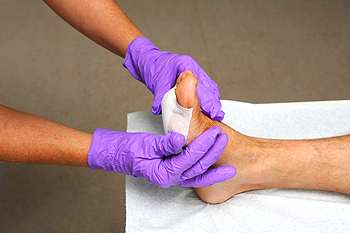Items filtered by date: February 2023
Infections From Puncture Wounds

The feet, like almost all other parts of the human body, are susceptible to developing wounds. Wounds are the result of some kind of injury to the skin of the feet, and they come in many different types. Puncture wounds, for example, can develop on the feet when some kind of sharp object cuts through the skin on the feet. Everyone who wants to protect the health of their feet ought to be familiar with puncture wounds because it is possible for an individual to develop an infection. Infections can sometimes be a consequence of a puncture wound because, if it is left untreated, the object that caused the wound might have carried some damaging bacteria. If you have a puncture wound, it is suggested that you see a podiatrist who can help you keep it clean and free from infection.
Wound care is an important part in dealing with diabetes. If you have diabetes and a foot wound or would like more information about wound care for diabetics, consult with Gregory Rorick, DPM from Rorick Podiatry, PC. Our doctor will assess your condition and provide you with quality foot and ankle treatment.
What Is Wound Care?
Wound care is the practice of taking proper care of a wound. This can range from the smallest to the largest of wounds. While everyone can benefit from proper wound care, it is much more important for diabetics. Diabetics often suffer from poor blood circulation which causes wounds to heal much slower than they would in a non-diabetic.
What Is the Importance of Wound Care?
While it may not seem apparent with small ulcers on the foot, for diabetics, any size ulcer can become infected. Diabetics often also suffer from neuropathy, or nerve loss. This means they might not even feel when they have an ulcer on their foot. If the wound becomes severely infected, amputation may be necessary. Therefore, it is of the upmost importance to properly care for any and all foot wounds.
How to Care for Wounds
The best way to care for foot wounds is to prevent them. For diabetics, this means daily inspections of the feet for any signs of abnormalities or ulcers. It is also recommended to see a podiatrist several times a year for a foot inspection. If you do have an ulcer, run the wound under water to clear dirt from the wound; then apply antibiotic ointment to the wound and cover with a bandage. Bandages should be changed daily and keeping pressure off the wound is smart. It is advised to see a podiatrist, who can keep an eye on it.
If you have any questions, please feel free to contact our office located in New York Mills, Utica, NY . We offer the newest diagnostic and treatment technologies for all your foot care needs.
Foot Arch Types and Gait

There are several different types of running shoes, and it can help to determine what type of running will be done before they are purchased. There are two important things to look for when considering buying running shoes. Comfort and stability as the foot lies in and moves through the shoe is one thing, and having adequate shock absorption is another. Additionally, it is beneficial the shoes can provide enough flexibility while having the proper amount of support, which can ultimately improve running performance. Experienced runners know the importance of determining what type of foot arch they have, in addition to knowing what their gait, or walking style is. The arches are categorized into three types, consisting of normal, high and low. Having a gait assessment is helpful in choosing the right type of running shoes, which can include motion control, stability, or neutral cushioning. If you would like more information about how to choose the right running shoe, please consult with a podiatrist.
If you are a runner, wearing the right running shoe is essential. For more information, contact Gregory Rorick, DPM from Rorick Podiatry, PC. Our doctor can provide the care you need to keep you pain-free and on your feet.
Choosing the Right Running Shoe for Your Foot Type
To increase performance and avoid the risk of injury, it is important to choose the right running shoe based on your foot type. The general design of running shoes revolves around pronation, which is how the ankle rolls from outside to inside when the foot strikes the ground.
- Neutral runners are able to choose from a wide variety of shoes, including minimalist shoes or even going barefoot.
- Runners who overpronate, or experience an over-abundance of ankle rolling, should choose shoes that provide extra motion control and stability.
- Runners who underpronate, or supinate, have feet that have high arches and lack flexibility, preventing shock absorption. They require shoes with more flexibility and cushion.
If you have any questions please feel free to contact our office located in New York Mills, Utica, NY . We offer the newest diagnostic and treatment technologies for all your foot and ankle needs.
Running and Foot Pain

It is not surprising that with the extra stress running can put on the feet, runners may be more prone to foot injuries. Runners with flat feet, high arches, and those who overpronate are at higher risk for foot injuries than others. Afflictions that are common among runners include plantar fasciitis, metatarsalgia, and Morton’s neuroma. Plantar fasciitis is when the plantar fascia, a thick band of fibrous tissue that runs along the bottom of the foot, from heel to toes, becomes inflamed or tears. It can cause a stabbing pain in the heel which may worsen when climbing stairs, after prolonged standing, and after getting out of bed in the morning. Metatarsalgia develops when excess pressure is put on the metatarsal bones, which are the long bones of the foot leading to the toes. With this condition, one might feel there are pebbles in the shoe or bruising on the balls of the feet. Pain is felt between the second and third toes, third and fourth toes, or near the big toe. A Morton’s neuroma can also feel like one is walking on a pebble, and there is discomfort near the ball of the foot. This is when a fibrous tissue grows around a nerve in the foot causing burning and tingling sensations, numbness, or pain in the foot. If you are a runner and have foot pain, see a podiatrist to determine its cause and start treatment that might be helpful to you.
Ankle and foot injuries are common among athletes and in many sports. They can be caused by several problems and may be potentially serious. If you are feeling pain or think you were injured in a sporting event or when exercising, consult with Gregory Rorick, DPM from Rorick Podiatry, PC. Our doctor will assess your condition and provide you with quality foot and ankle treatment.
Common Injuries
The most common injuries that occur in sporting activities include:
- Achilles Tendonitis
- Achilles Tendon Rupture
- Ankle Sprains
- Broken Foot
- Plantar Fasciitis
- Stress Fractures
- Turf Toe
Symptoms
Symptoms vary depending upon the injury and in some cases, there may be no symptoms at all. However, in most cases, some form of symptom is experienced. Pain, aching, burning, bruising, tenderness, tightness or stiffness, sensation loss, difficulty moving, and swelling are the most common symptoms.
Treatment
Just as symptoms vary depending upon the injury, so do treatment options. A common treatment method is known as the RICE method. This method involves rest, applying ice, compression and elevating the afflicted foot or ankle. If the injury appears to be more serious, surgery might be required, such as arthroscopic or reconstructive surgery. Lastly, rehabilitation or therapy might be needed to gain full functionality in the afflicted area. Any discomfort experienced by an athlete must be evaluated by a licensed, reputable medical professional.
If you have any questions, please feel free to contact our office located in New York Mills, Utica, NY . We offer the newest diagnostic and treatment technologies for all your foot care needs.
Relief Options for Hammertoe

The center toes are affected by a foot condition that is known as hammertoe. It is considered to be a deformity, and may happen from wearing shoes that are too tight in the toe area. It may also develop from genetic reasons, or possibly from a toe injury. Hammertoe is a noticeable condition. It causes the middle joint in the second or third toe to bend upward, which makes the toe bend down. Patients have found mild relief when the correct size shoes are worn, in addition to performing specific stretches that may help in flexibility. The toes may also become stronger when marbles or stones are picked up with the feet. Additionally, some people choose to wear protective pads over the top of the toes, which may help in preventing corns from developing. In severe cases, surgery may be recommended which may permanently straighten the toes, allowing the tendons to lie flat. If you have hammertoe, and would like relief options, it is suggested that you seek the counsel of a podiatrist who can provide you with the information you are seeking.
Hammertoe
Hammertoes can be a painful condition to live with. For more information, contact Gregory Rorick, DPM from Rorick Podiatry, PC. Our doctor will answer any of your foot- and ankle-related questions.
Hammertoe is a foot deformity that affects the joints of the second, third, fourth, or fifth toes of your feet. It is a painful foot condition in which these toes curl and arch up, which can often lead to pain when wearing footwear.
Symptoms
- Pain in the affected toes
- Development of corns or calluses due to friction
- Inflammation
- Redness
- Contracture of the toes
Causes
Genetics – People who are genetically predisposed to hammertoe are often more susceptible
Arthritis – Because arthritis affects the joints in your toes, further deformities stemming from arthritis can occur
Trauma – Direct trauma to the toes could potentially lead to hammertoe
Ill-fitting shoes – Undue pressure on the front of the toes from ill-fitting shoes can potentially lead to the development of hammertoe
Treatment
Orthotics – Custom made inserts can be used to help relieve pressure placed on the toes and therefore relieve some of the pain associated with it
Medications – Oral medications such as anti-inflammatories or NSAIDs could be used to treat the pain and inflammation hammertoes causes. Injections of corticosteroids are also sometimes used
Surgery – In more severe cases where the hammertoes have become more rigid, foot surgery is a potential option
If you have any questions please contact our office located in New York Mills, Utica, NY . We offer the newest diagnostic and treatment technologies for all your foot and ankle needs.

